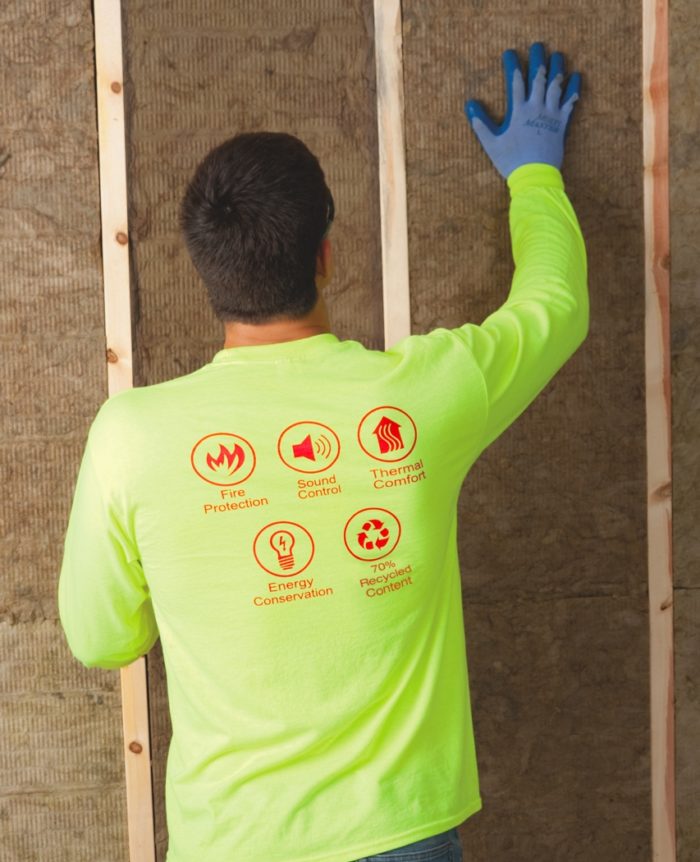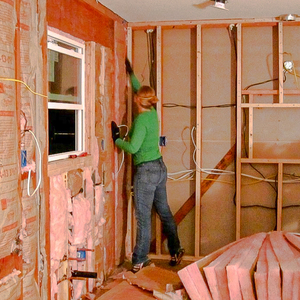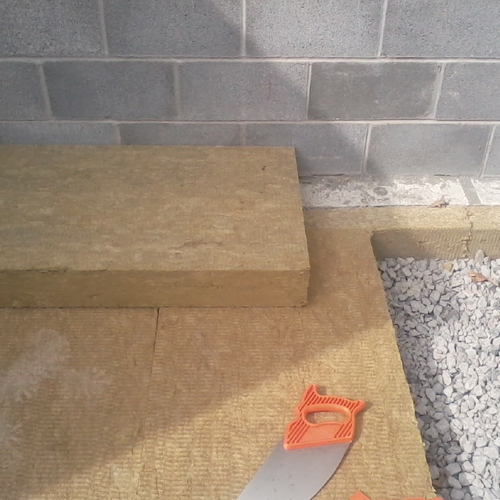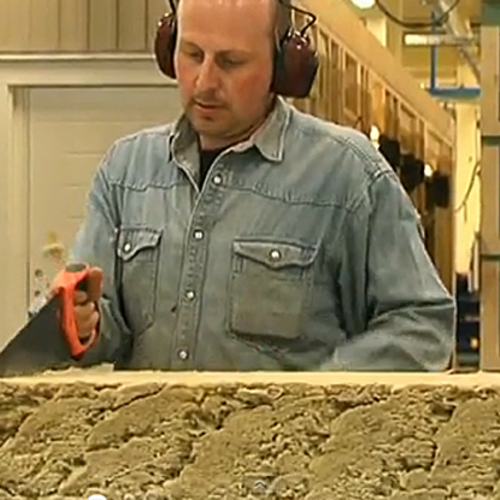Image Credit: Thermafiber
Image Credit: Thermafiber UltraBatt mineral wool insulation is denser than fiberglass batts but more compressible than rigid foam insulation.
Image Credit: Thermafiber
Back in May of this year I wrote about a new rigid mineral wool insulation product from Roxul and how it can be used in place of foam-plastic insulation materials like polystyrene in certain applications. I’ve been revising the BuildingGreen Guide to Insulation Products and Practices and dug back into lots of insulation products. There are some new mineral wool developments to report.
Before getting into the details, here’s a little background: Mineral wool, variously referred to as rock wool, slag wool, and stone wool, was one of the first insulation materials to be widely produced commercially — starting back in 1871 in Germany.
Rockwool International, the world’s largest producer of mineral wool and the parent company of Canadian manufacturer Roxul, began production of the material in 1937. The U.S. company Thermafiber, one of the largest U.S. producers of the material and a company poised for rapid growth today, was founded in 1934.
Mineral wool is made by melting the raw material, which can be stone (such as basalt) and/or iron ore slag, at very high temperature, spinning it like cotton candy to produce very thin fibers, coating those fibers with a binder to hold them together, and forming it into the insulation batt or boardstock material to meet specific product needs.
Mineral wool lost most of its market share when less-expensive fiberglass insulation came along, but unique properties of the material have been fueling a comeback in recent years — and this year the world’s largest fiberglass insulation company, Owens Corning, purchased Thermafiber. With this development, I’m expecting to see a lot of attention paid to mineral wool in the coming years — led by a new product introduction last week.
Why I like mineral wool
Mineral wool is highly fire resistant, which has long made it an insulation material of choice in many commercial buildings. It achieves its fire resistance without the use of any flame retardant chemicals, which are widely used in most foam-plastic insulation materials — and which I believe to be a huge downside of those products.
Mineral wool is a heavier and denser insulation material that fiberglass, giving it better sound-control properties and more effectively restricting air movement through it. When produced in boardstock form, mineral wool can be rigid enough to work as insulative sheathing, like extruded polystyrene and polyisocyanurate.
Mineral wool can also contain very high recycled content by using iron ore slag (a waste product from steel manufacturing). Some mineral wool products on the market have over 90% recycled content — higher even than cellulose insulation, though it is made from post-industrial rather than post-consumer recycled material.
The downside to mineral wool
There are three downsides to mineral wool. One is that mineral fibers can break off and become airborne; when we breathe those fibers in they can cause health problems. In the past there was some concern that mineral wool and fiberglass fibers might be carcinogenic, like asbestos. While those concerns have largely been dismissed, the fibers are still respiratory irritants. Installers of mineral wool should always wear quality dust masks, and the material should be adequately covered with drywall or coatings that prevent fibers from entering the indoor air in a building.
The second downside is the binder used to glue the fibers together. Manufacturers use a phenol formaldehyde or a urea-extended phenol formaldehyde binder. Formaldehyde is a known human carcinogen, and if a lot of it escapes into the indoor air, that would clearly be a health concern. Fortunately, the processing drives off nearly all of the free formaldehyde in the material, so formaldehyde emissions from mineral wool have extremely low formaldehyde levels — in some cases as low as background formaldehyde levels.
Nonetheless, there is a perception problem with formaldehyde binders — if not a real problem — and manufacturers are working on alternatives — as has occurred with fiberglass insulation. I fully expect that within a few years one of the mineral wool manufacturers will announce a biobased binder that works with mineral wool and the industry will fairly quickly convert to such a binder.
The third downside to mineral wool is that it can be hard to work with. Mineral wool boardstock is more compressible than rigid foam-plastic insulation, so installing strapping over it may take special care. In the batt form, the insulation doesn’t compress as easily as fiberglass to squeeze into odd corners and around wires. That can make mineral wool harder to work with — but it should also prevent some of the worst installation problems that occur with fiberglass. (The effectiveness of all types of batt insulation depends to a very significant extent on the care taken during installation.)
Thermafiber’s new mineral wool batt insulation
The latest news with mineral wool is the introduction by Thermafiber (now an Owens Corning company) of UltraBatt, a flexible batt insulation product for 2×4 or 2×6 walls. This follows Roxul’s introduction of a widely distributed mineral wool batt insulation product, ComfortBatt, several years ago.
UltraBatt is a fairly dense batt (not compressible like fiberglass batts) that offers very good sound control as well as relatively high insulating values. The 3 1/2-inch batts for 2×4 walls provide R-15, and the 5 1/2-inch batts for 2×6 walls provide R-23 — though, as with all cavity-fill insulation, the actual “whole-wall” R-value will be lower, due to thermal bridging through the studs.
UltraBatt is comprised of 70% post-industrial recycled content. As for pricing, the national distributor Menards showed the online price to be about $31 per 40 square feet in the 3 1/2-inch batts, or about $0.77 per square foot. This compares with unfaced CertainTeed fiberglass batts at about $23 for 88 square feet, or $0.26 per square foot. The installed cost of dense-packed cellulose, meanwhile, is typically $1 to $2 per square foot for a 2×4 wall, though the pricing of any contractor-installed insulation is very dependent on the project.
I have not seen test data on formaldehyde (or other) emissions from UltraBatt, but I was told by Owens Corning that testing is underway and findings will be reported in 2014. I suspect that, like Roxul’s ComfortBatt, the formaldehyde emissions will be very low.
Alex is founder of BuildingGreen, Inc. and executive editor of Environmental Building News. In 2012 he founded the Resilient Design Institute. To keep up with Alex’s latest articles and musings, you can sign up for his Twitter feed.
Weekly Newsletter
Get building science and energy efficiency advice, plus special offers, in your inbox.
















9 Comments
It was my understanding...
... that the aerosol microfiber issues with rock wool were orders of magnitude lower than fiberglass. Can't put my finger on where I read that, but can anyone point to sources outlining the degree to which it's a problem with rock wool vs. fiberglass?
My personal perception when handling & installing rock wool is that it's less of an issue. When cutting batts the stuff hanging in the air SEEMS to settle out comparatively quickly, but I can't say for certain whether that's a perception driven by expectations.
dana
Off-Gassing?
Does the formaldehyde "off-gas" during its lifetime or is the concern mainly with the loose fibers?
I assume when tucked behind drywall the mineral wool will be safe to the occupants of the home?
When compared to fiberglass (which isn't great to breathe either), I believe mineral wool has many more advantages to it. The 1500F fire rating, greater R-Value per inch, and excellent STC ratings, are far superior than fiberglass.
Toxicity of "Fine Mineral Wool Fibers"
Dana,
This is the only document I can find that talks about the toxicity of these mineral wool fibers, but it lumps them with glass wool fibers which I figure is fiberglass.
http://www.epa.gov/ttnatw01/hlthef/finemineral.html
I think you are exactly right about how quickly it settles out is probably one way to measure the risk. Larger fibers are less likely to be suspended in the air and inhaled. And if mineral wool is "heavier" then it is less likely to remain suspended.
Density and Permeability
Alex,
Is the Ultrabatt expected to have a similar density and perm rating as the Roxul Comfortbatt IS you wrote about previously? I would think the density would be lower as it is a "flexible batt" rather than board stock, and so I wouldn't think this could be used as effectively as the Comfortbatt IS in an exterior application. However, I mostly wonder about its permeability.
Response to Mike LaCrosse
Mike,
If you are asking about permeability to water vapor -- all types of rock wool insulation, no matter their density, are very permeable indeed. Water vapor goes right through the insulation.
air permeable, but air retardent
Rock wool at any density is highly permeable to both air and water vapor, but all rock wool batt materials are fairly air-RETARDENT in comparison to typical fiberglass batts. The higher density "cathedral ceiling" batts are about as air retardent as standard rock wool batts (and about the same R/inch too.)
Toxicity
Alex,
The Mineral Wool manufacturers really need to step up and clear up the Formaldehyde issue before it's acceptable to recommend for an interior insulation material in a green (or non-green..) home. There's a big disconnect between their own publicly released information.
If you look at Roxul's MSDS sheet for their mineral wool batt insulation (http://www.roxul.com/files/RX-NA_EN/pdf/Roxul%20Material%20Safety%20Data%20Sheet.pdf) they list between 1% - 6% Urea Formaldehyde in their product. This would be completely unacceptable for an indoor product.
However, they have some of their batt insulation products (but not the high density board products) listed as GreenGuard certified (http://www.greenguard.org/en/SearchResults.aspx?CategoryID=2&SubCategoryID=8&BrandID=438), is this enough proof for us to feel safe specifying this product in an interior use in your opinion?
We've heard claims from sales reps that the Urea Formaldehyde is burned off in the manufacturing process, is the Greenguard certification enough proof of that?
Establishing spray-on insulation in India
I was last week in Delphos-USA and visited Krendl to buy spray-on insulation machines using cellulose, fiberglass & mineral fiber. We are projecting to buy around 100 machines in the next 3 years after our operations start in April 2014. We are looking for manufactures & suppliers of all types of fibers and suitable glue to be imported in India.
India is a big market and the spray-on system is not existing here at moment so we decided to introduce it in India.
Can anyone help us to introduce known manufacturers worldwide ?
What is the future of this project ?
Mineral wool material is a versatile fibrous material made from drawing rock materials or molten minerals such as ceramics or slag. This material exhibits properties such as noise reduction, fire resilience, mold resistance and thermal protection. Mineral Wool Material Market size exceeded USD 14.5 billion, globally in 2018 and it will surpass USD 22.5 billion by 2026. Source: https://bit.ly/2wvlbUy
Log in or create an account to post a comment.
Sign up Log in